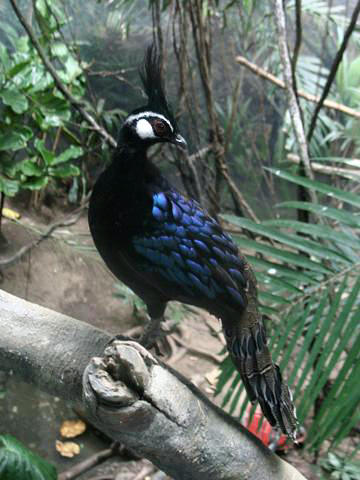|
| Query: Polyplectron bicalcaratum | Result: 16th of 18 | |
Peacock-pheasant (Genus: Polyplectron) - Wiki
| Subject: | Peacock-pheasant (Genus: Polyplectron) - Wiki
| |

| Resolution: 360x480
File Size: 39756 Bytes
Upload Date: 2008:01:02 09:35:18
|
Polyplectron
From Wikipedia, the free encyclopedia
Order: Galliformes
Family: Phasianidae
Genus: Polyplectron
[Photo] male Palawan Peacock-pheasant, Polyplectron napoleonis. Location: Bronx Zoo, New York - Author: http://commons.wikimedia.org/wiki/User:Stavenn | Permission is granted to copy, distribute and/or modify this document under the terms of the GNU Free Documentation License, Version 1.2 or any later version published by the Free Software Foundation; with no Invariant Sections, no Front-Cover Texts, and no Back-Cover Texts. A copy of the license is included in the section entitled "GNU Free Documentation License". |
The genus Polyplectron of the family Phasianidae consist of seven peacock-pheasant species. The male peacock-pheasants have varying display plumage, while the females are colored far more inconspicuously.
The systematics of the genus are somewhat unclear. The species of Polyplectron evolved at some time between, roughly, the Early Pliocene and the Middle Pleistocene, or 5-1 mya. The morphologically somewhat aberrant Polyplectron malacense and its little-known sister species Polyplectron schleiermacheri form a basal radiation around the southern South China Sea together with the striking Polyplectron napoleonis, as is confirmed by comparison of biogeography and mtDNA cytochrome b and D-loop as well as the nuclear ovomucoid intron G (Kimball et al. 2001).
The relationships of the other forms are more poorly understood. Polyplectron germaini and Polyplectron bicalcaratum are similar in morphology and are nearly parapatric; the molecular data suggests that the latter is a symplesiomorphy, but with not too high confidence. In any case, the brownish insular or peninsular species chalcurum and inopinatum do not seem to be derived from a single isolation event, and seem to have acquired the more subdued coloration independently. The trend in this genus to lose, not to gain, pronounced sexual dimorphism is better supported by biogeographical and molecular data than the alternate scenario.(Kimball et al. 2001)
Species
Palawan Peacock-pheasant, Polyplectron napoleonis - formerly Polyplectron emphanum
Malayan Peacock-pheasant, Polyplectron malacense
Bornean Peacock-pheasant, Polyplectron schleiermacheri
Germain's Peacock-pheasant, Polyplectron germaini
Grey Peacock-pheasant, Polyplectron bicalcaratum
Bronze-tailed Peacock-pheasant, Polyplectron chalcurum
Mountain Peacock-pheasant, Polyplectron inopinatum
http://en.wikipedia.org/wiki/Polyplectron
| The text in this page is based on the copyrighted Wikipedia article shown in above URL. It is used under the GNU Free Documentation License. You may redistribute it, verbatim or modified, providing that you comply with the terms of the GFDL. |
|
Comments |
|---|
| | Chickaba |
|
| hi, my name is chickaba, and i wanna eat a peacock, do u kno how to cook one? |

|

|

|
Polyplectron bicalcaratum
16/18 |

|
 |
^o^
Animal Pictures Archive for smart phones
^o^
|
|
|